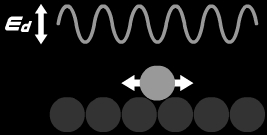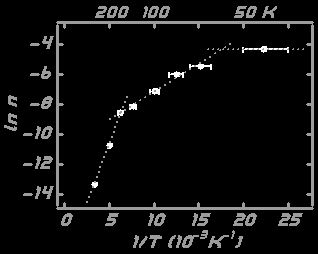
Island density
Atoms diffuse randomly on a surface at a certain diffusion rate
and form islands when they meet each other.

Fig. 1. Schematic illustration of diffusion barrier.
The diffusion rate can be given in the Arrhenius form by ν = ν0exp(-Ed/kBT),
where Ed is the diffusion barrier as shown in Fig. 1, ν0 is the attempt frequency,
kB is the Boltzmann factor, and T is the temperature.
The surface diffusion rate can be obtained by measuring the island density as a function of temperature.
Figure 2 shows STM images of Au islands grown on Ir(111) as a function of sample temperature.
The island density increases with decreasing sample temperature.

Fig. 2. STM images of Au islands grown on Ir(111) at (A) 300 K, (B) 160 K, and (C) 80 K.
Image sizes are (A) 1000×1000 nm2, (B) 200×200 nm2, and (C) 100×100 nm2 (inset 15×15 nm2).
According to the mean-field nucleation theory [1], island density n is given by
n = η(4F/ν)i/(i+2)exp(Ei/(i+2)kBT),
where η is a numerical parameter, F is the deposition rate, i is the critical island size,
Ei is the binding energy of the i-island (E1 = 0).
Figure 3 shows the Arrhenius plot of the Au island density on Ir(111).

Fig. 3. Arrhenius plot of Au island density on Ir(111).
From the slope and intercept of the line in the Arrhenius plot in the range from 66 to 160 K (i = 1),
Ed = 0.094 ± 0.007 eV and ν0 = 2.8×109±1.3 s-1 have been estimated [2].
References
[1] J. A. Venables, Philos. Mag. 27, 697 (1973).
[2] S. Ogura et al., J. Phys. Conf. Ser. 100, 072003 (2008).
